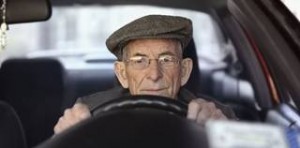
Seniors age 75 and greater are in the highest percentile of all drivers for daytime auto accidents. A study conducted by Carnegie Mellon University and the AAA Foundation for Traffic Safety based on data collected between 1999 and 2004 found that drivers age 75-85 die at a rate of 3 per 100 million miles driven. That’s about on par with the death rate for teenagers. For drivers 85 and older, however, the fatality rate is four times that of their teen counterparts. Consequently, insurance premiums for older drivers can skyrocket, especially if they don’t have a perfectly clean driving record.
In spite of decades of experience behind the wheel, senior drivers do suffer from slower reaction times as a natural consequence of aging. Most compensate for this deficiency on their own, choosing routes that do not take them on streets with heavy traffic or confusing intersections. Unfortunately, it’s not always possible to route around problems areas. When that is the case, the coping mechanism itself tends to work against older drivers. Having grown less accustomed to challenging traffic situation, elderly drivers may be more prone to panic behind the wheel and make a poor decision or an error like hitting the accelerator instead of the brake.
Other factors that may affect an older driver’s ability to safely operate a car include limited mobility, which decreases their flexibility, making it difficult to twist in the seat and check the vehicle’s blind spots. Many medications warn against operating a motor vehicle due to a potential for dizziness, and the problem of unmonitored drug interactions is at epidemic levels among seniors. For obvious reasons, hearing and vision loss also constitute risk factors.
There’s no mystery why the insurance industry puts older drivers in a higher risk category, but that does not mean seniors who are safe drivers can’t seek discounts. One of the best avenues at their disposal, through AARP, is to participate in a senior safety driving program. This is essentially defensive driving for elders and can result in discounts of 5-10 percent. Actually, it’s entirely possible to take defensive driving and a senior safety program and get a double discount. Since these courses generally cost no more than $30 and may be as short as 8 hours in duration, it’s well worth the time and effort.
Senior drivers may also benefit from new pay-as-you-drive insurance models like the Snapshot program now offered by Progressive in more than 20 states. A small telematic device is plugged into the car’s onboard diagnostic port (present in post-1996 models) and data is collected for one month to determine eligibility for discounts of as much as 30 percent. Collected data includes speed driven, mileage, and time of day. Unfortunately, although seniors likely do drive fewer miles and do not drive as often at night, they might not qualify for the coverage if they drive too slow, a common problem in their age group, and a habit which can be as dangerous or more so than speeding.





